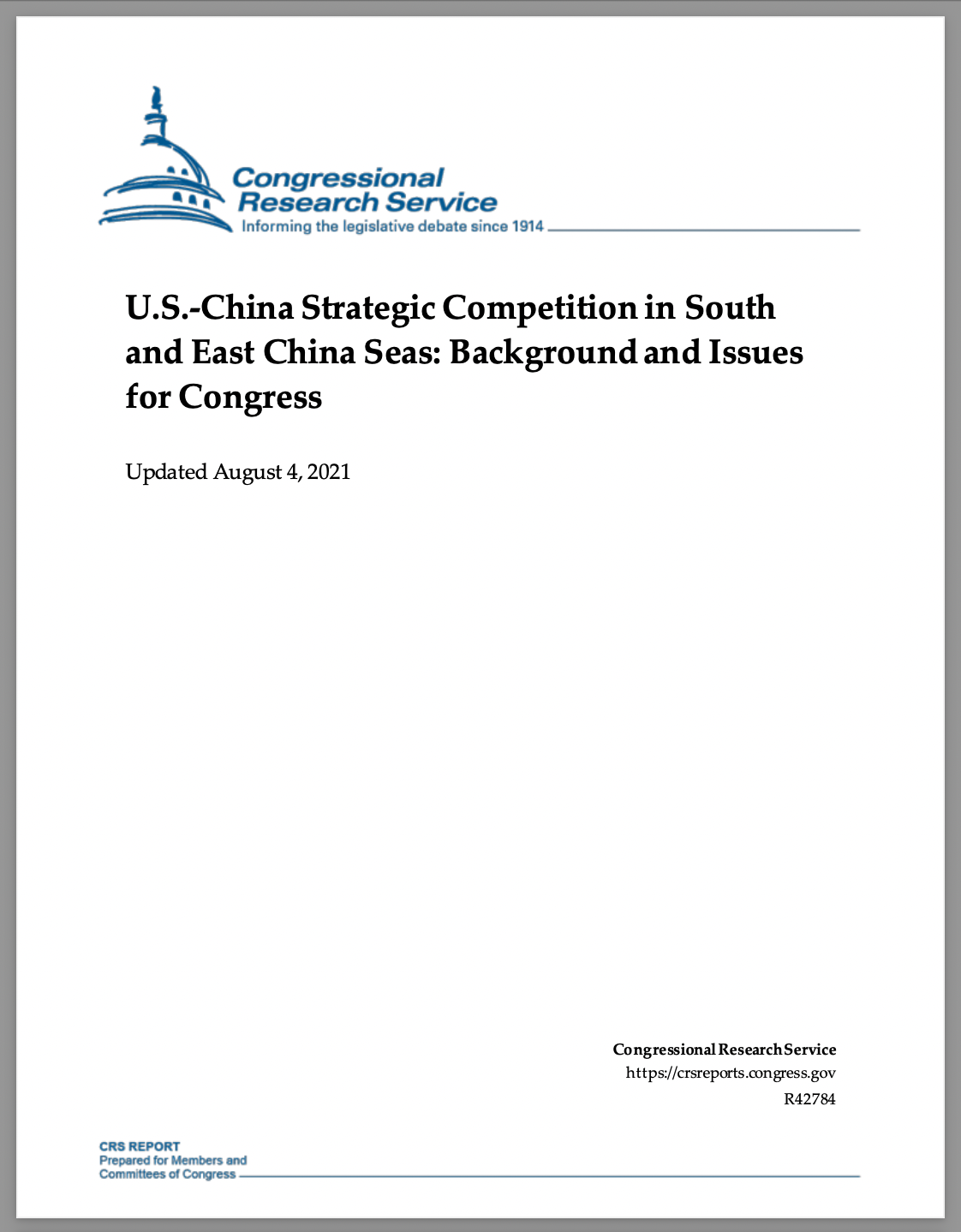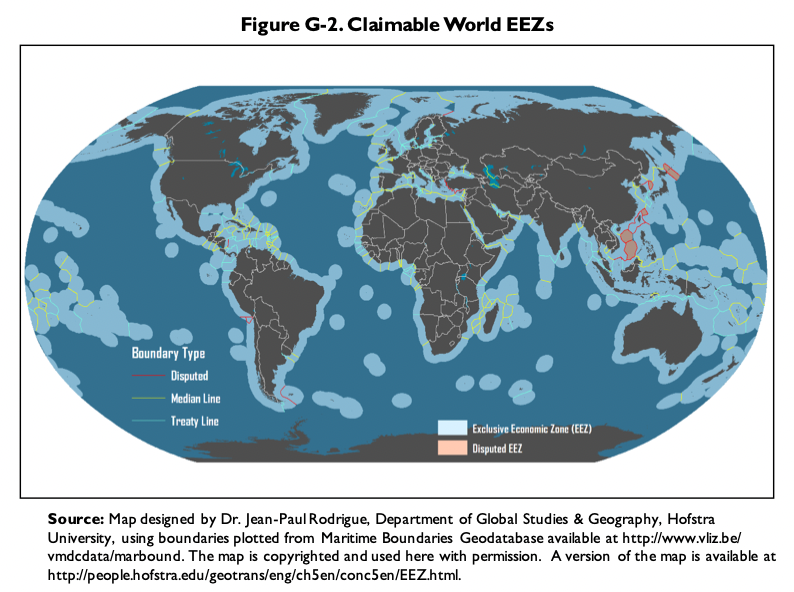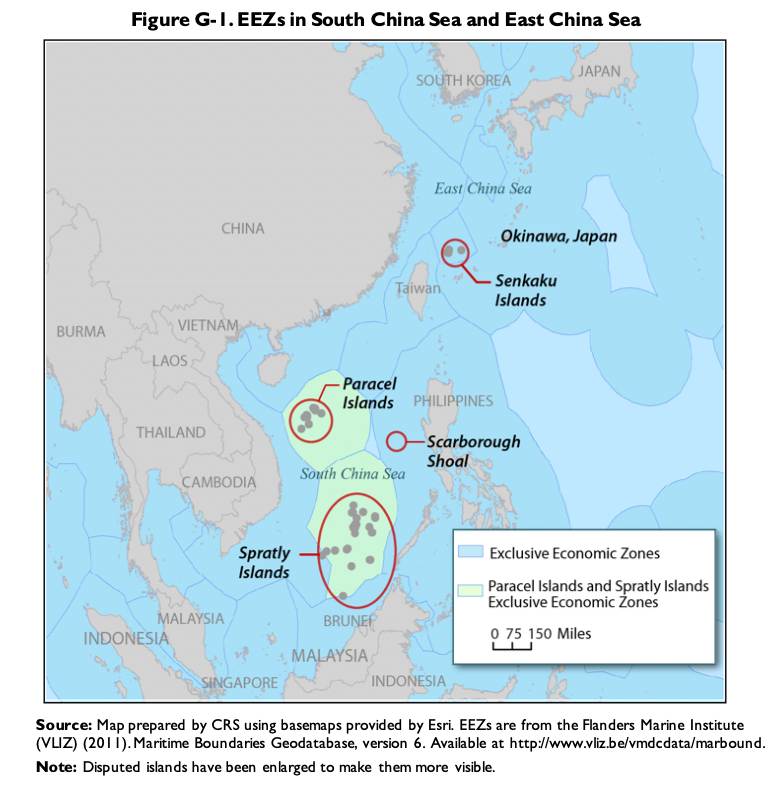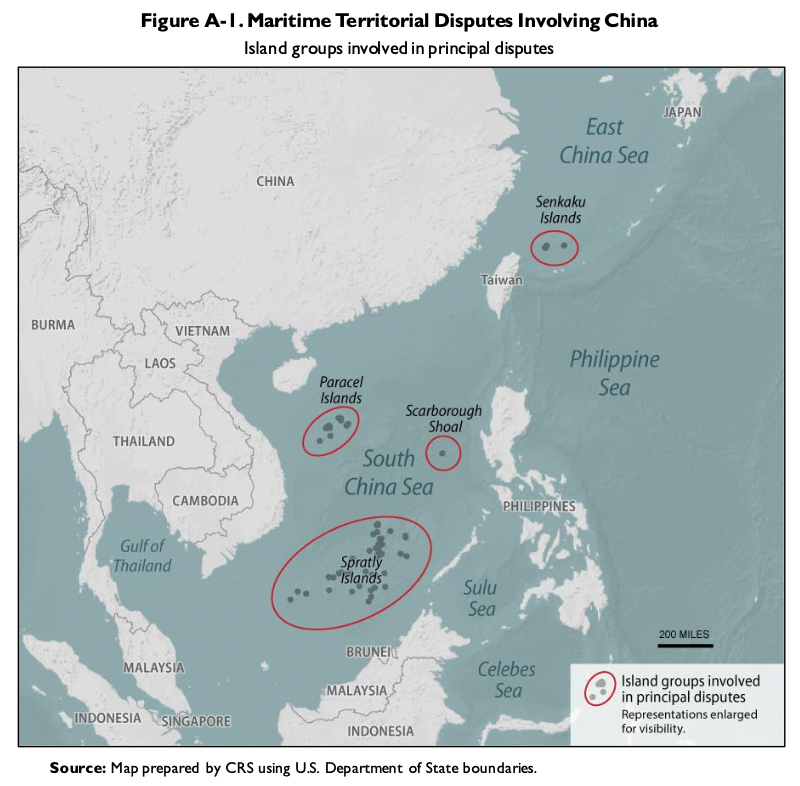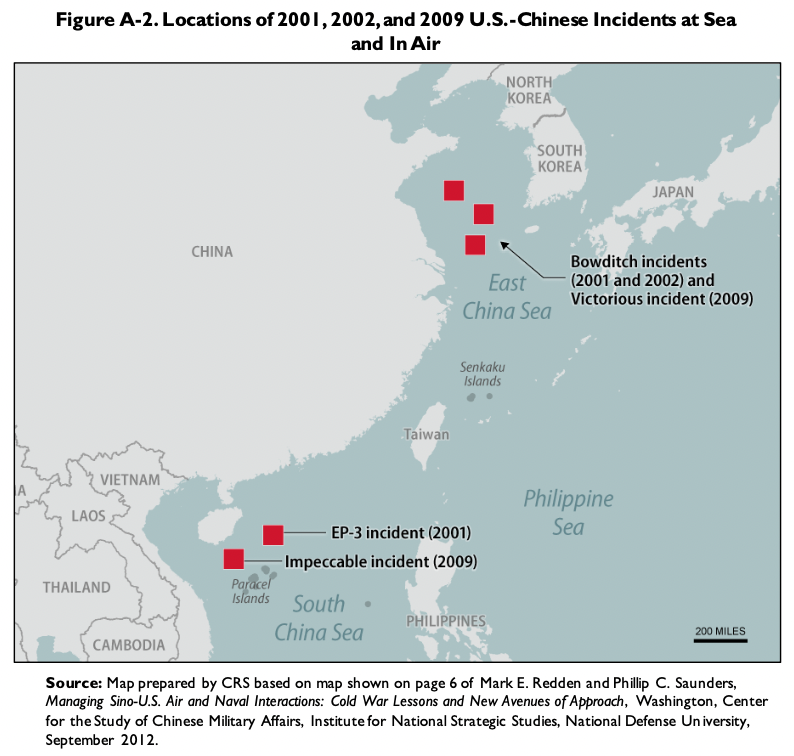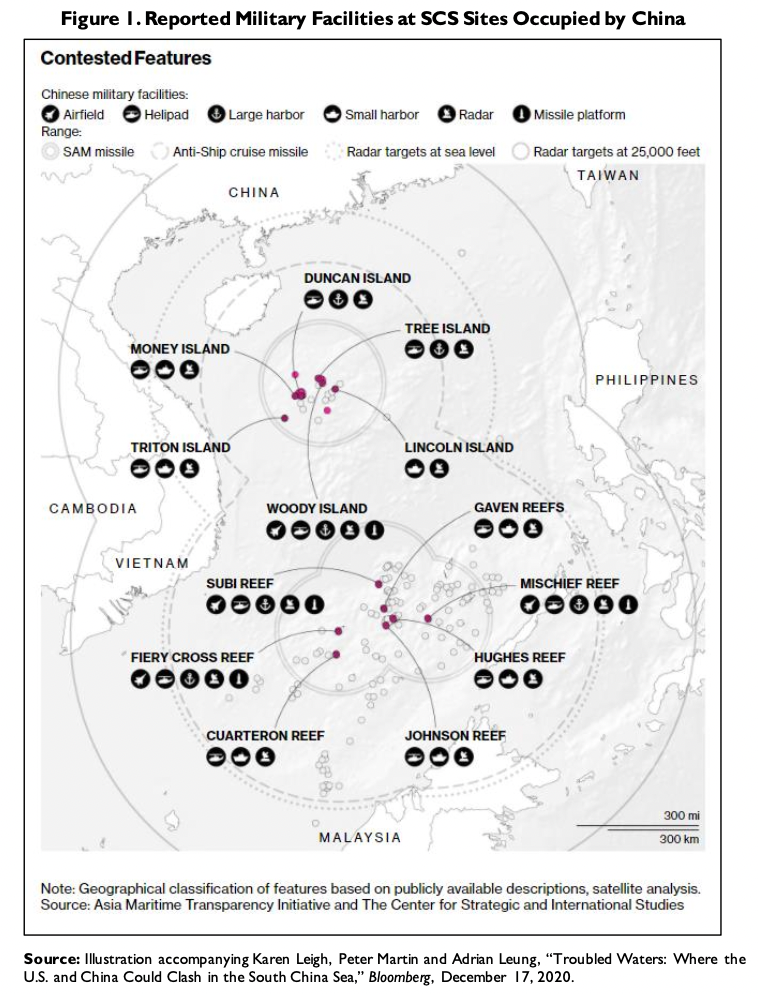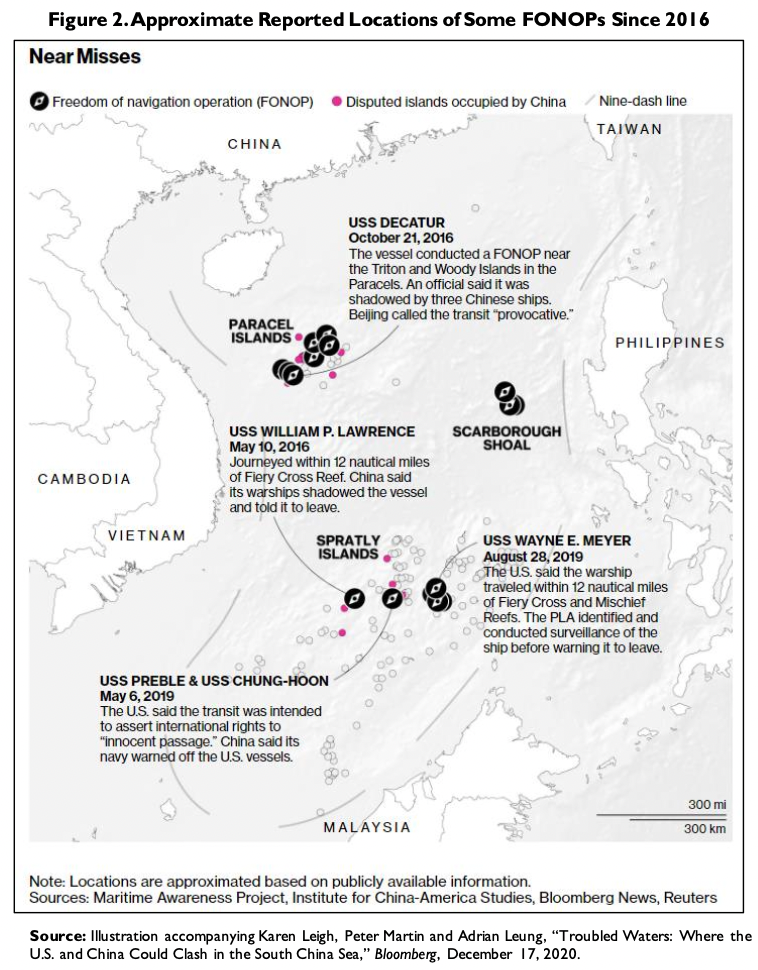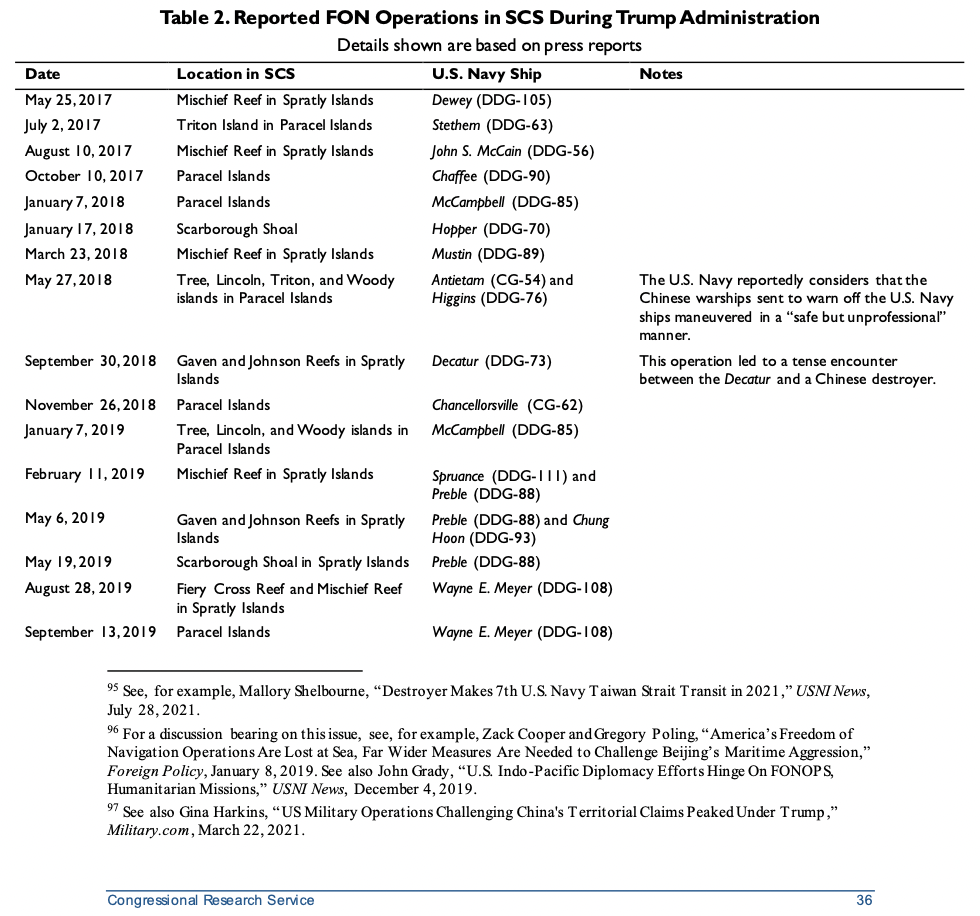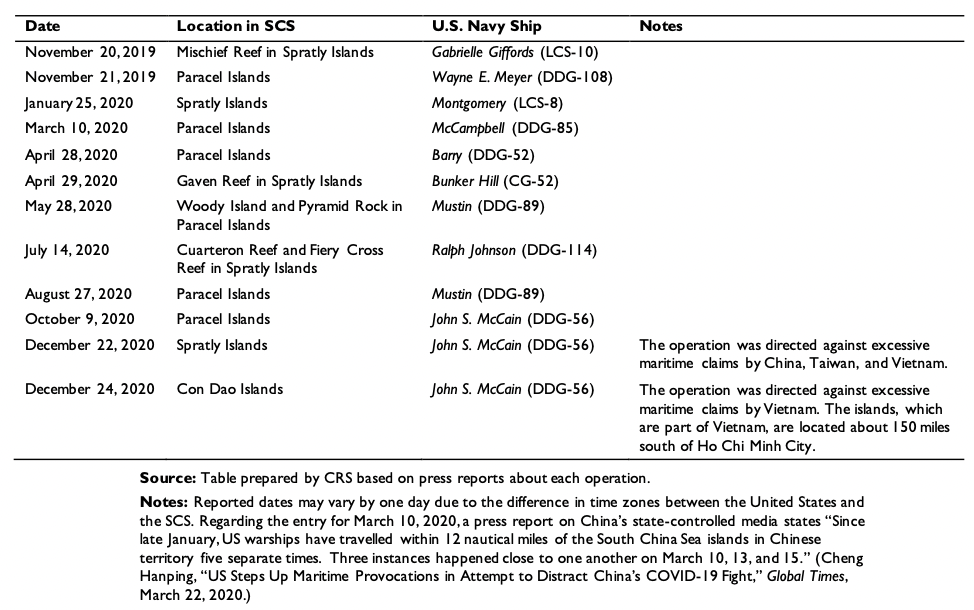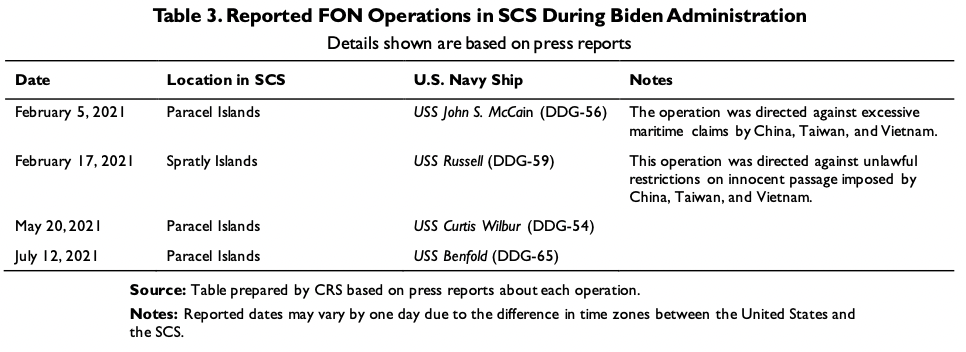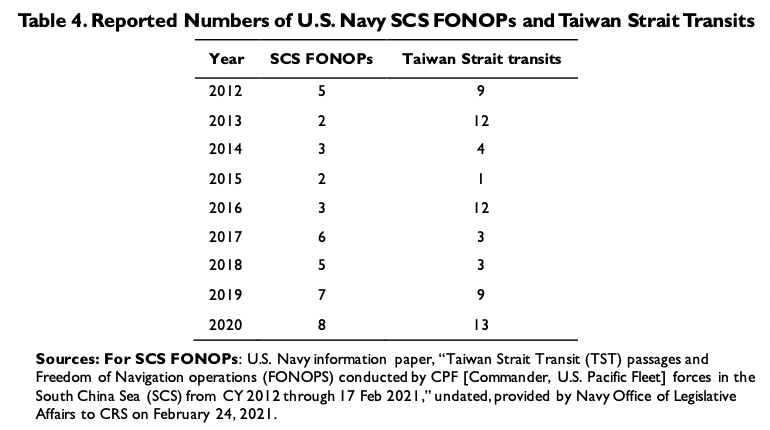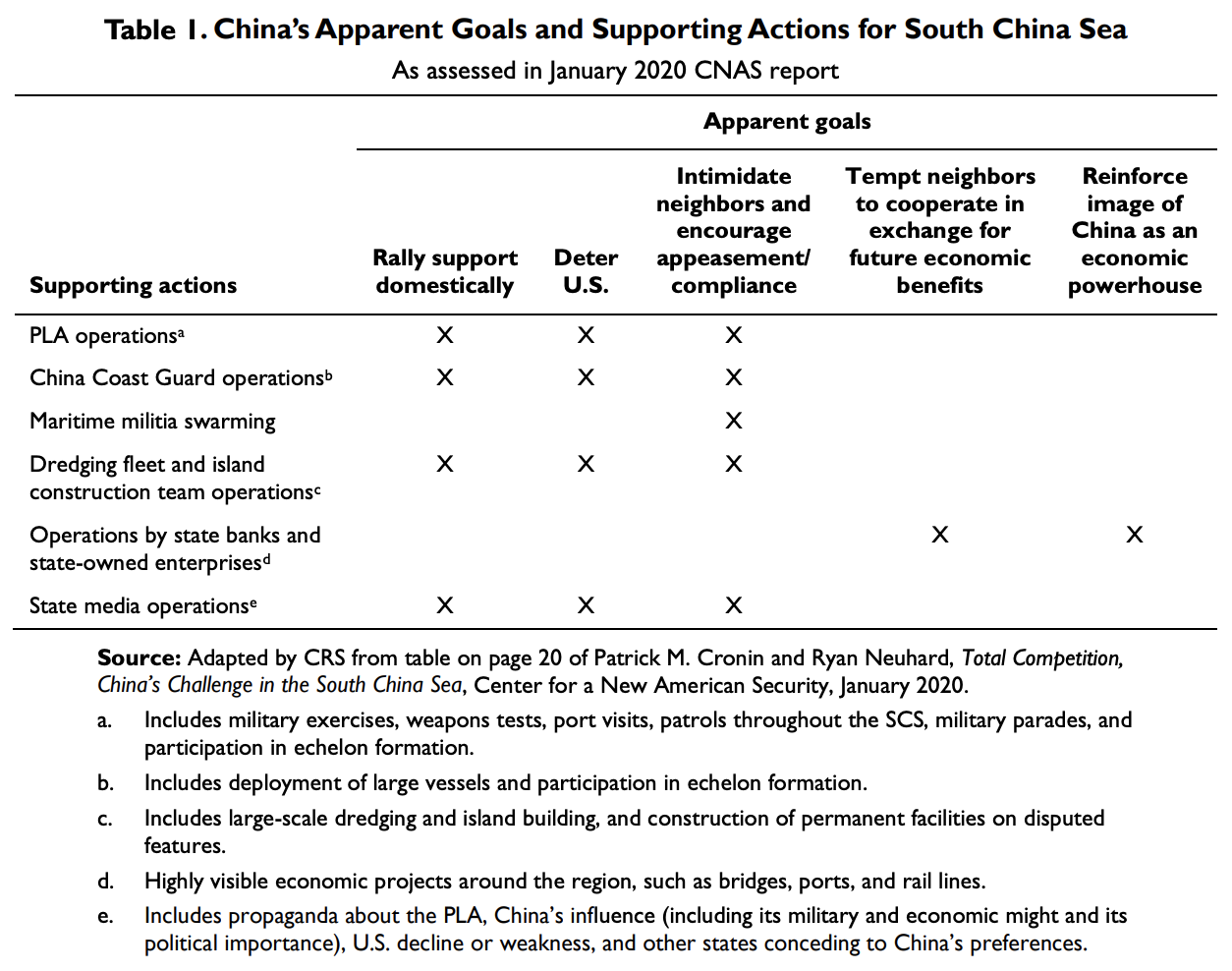Latest on CCG + PAFMM & Gray Zone Ops—“U.S.-China Strategic Competition in South & East China Seas”—O’Rourke’s Newest CRS Report
If you have trouble accessing the website above, please download a cached copy here.
You can also click here to access the report via the public CRS website.
KEY EXCERPTS:
p. 9
p. 9
“Salami-Slicing” Strategy and Gray Zone Operations
Observers frequently characterize China’s approach to the SCS and ECS as a “salami-slicing” strategy that employs a series of incremental actions, none of which by itself is a casus belli, to gradually change the status quo in China’s favor. Other observers have referred to China’s approach as a strategy of gray zone operations (i.e., operations that reside in a gray zone between peace and war), of incrementalism,30 creeping annexation31 or creeping invasion,32 or as a “talk and take” strategy, meaning a strategy in which China engages in (or draws out) negotiations while taking actions to gain control of contested areas.33 AMarch 17, 2020, press report in China’s state-controlled media stated that “Chinese military experts on Tuesday [March 17]
***
30 See, for example, Patrick Mendis and Joey Wang, “China’s Art of Strategic Incrementalism in the South China Sea,” National Interest, August 8, 2020.
31 See, for example, Alan Dupont,“China’s Maritime Power Trip,” The Australian, May 24, 2014.
32 Jackson Diehl, “China’s ‘CreepingInvasion,” Washington Post, September 14, 2014.
33 The strategy has been called “talk and take” or “take and talk.” See, for example, Anders Corr, “China’s Take-And-Talk Strategy In The South China Sea,” Forbes, March 29, 2017. See also Namrata Goswami, “Can China Be Taken Seriously on its ‘Word’ to Negotiate Disputed Territory?”The Diplomat, August 18, 2017.
p. 10
suggested the use of non-lethal electromagnetic weapons, including low-energy laser devices, in expelling US warships that have been repeatedly intruding into the South China Sea in the past week.”34
A July 15, 2020, press report states
Its navy drills grab most of the attention, but China has also been quietly mounting a range of civilian and scientific operations to consolidate its claims in the South China Sea.
The diversified approach includes setting up a maritime rescue centre in Sansha, a prefecture-level city on Woody Island, which China calls Yongxing. It also involves undisclosed research and oil infrastructure.
Observers said the multipronged approach is meant to bolster China’s presence and consolidate its actual control over the waterway as other counties [sic:countries] repeatedly question its claims to the waters.35
Some observers argue that China is using the period of the COVID-19 pandemic to further implement its salami-slicing strategy in the SCS while the world’s attention is focused on addressing the pandemic.36 In a video conference with ASEAN foreign ministers in April 2020, Secretary of State Mike Pompeo reportedly stated “It is important to highlight how the Chinese Communist party is exploiting the world’s focus on the Covid-19 crisis by continuing its provocative behaviour. The CCP [Chinese Communist Party] is … coercing its neighbours in the South China Sea.”37
***
34 Liu Xuanzun, “US Intrusions in S. China Sea Can Be Stopped by Electromagnetic Weapons: Experts,” Global Times, March 17, 2020.
35 Kristin Huang,“The Under-the-Radar South China Sea Projects Beijing Uses to CementIts Claims,” South China Morning Post, July 15, 2020. See also Nguyen Thuy Anh, “Science Journals: A New Frontline in the South China Sea Disputes,” Asia Maritime Transparency Initiative (AMTI)(Center for Strategic and International Studies [CSIS]), July 15, 2020; Oriana Skylar Mastro, “How China Is Bending the Rules in the South China Sea,” Interpreter,February 17, 2021.
36 See, for example, T sukasa Hadano and Alex Fang, “China Steps Up Maritime Activity with Eye on Post-pandemic Order,” Nikkei Asian Review, May 13, 2020; Harsh Pant, “ China’s Salami Slicing overdrive: It’s Flexing Military Muscles at a Time When Covid Preoccupies the Rest of the World,”Times of India, May13, 2020; Veeramalla Anjaiah,“How To Tame Aggressive China In South China Sea Amid COVID-19 Crisis—OpEd,” Eurasia Review, May 14, 2020; Robert A. Manning and Patrick M. Cronin, “Under Cover of Pandemic, China Steps Up Brinkmanship in South China Sea,” Foreign Policy, May 14, 2020. Another observer, offering a somewhat different perspective, states
Recent developments in the South China Sea might lead one to assume that Beijing is taking advantage of the coronavirus crisis to further its ambitions in the disputed waterway. But it’s important to note that China has been following a long-term game plan in the sea for decades. While it’s possible that certain moves were made slightly earlier than planned because of the pandemic, they likely would have been made in any case, sooner or later.
(Steve Mollman,“China’s South China Sea Plan Unfolds Regardless of the Coronavirus,” Quartz, May 9, 2020.)
A May 3, 2020, press report stated
Analysts reject the idea that Beijing has embarked on a new South China Sea campaign during the pandemic. But they do believe the outbreak is having an effect on perceptions of Chinese policy.
“China is doing what it is always doing in the South China Sea, but it is a lot further along the road towards control than it was a few years ago,” said Gregory Poling, director of the Asia Maritime Transparency Initiative at CSIS, the Washington-based think-tank.
(Kathrin Hille and John Reed, “US Looks to Exploit Anger over Beijing’s South China Sea Ambitions,” Financial Times, May 3, 2020.)
37 As quoted in Kathrin Hille and John Reed, “US Looks to Exploit Anger over Beijing’s South China Sea Ambitions,” Financial Times, May 3, 2020. (Ellipsis as in original.)
p. 13
USE OF COAST GUARD SHIPS AND MARITIME MILITIA ………………………………………………………………………………………. 13
Use of Coast Guard Ships and Maritime Militia
Use of Coast Guard Ships and Maritime Militia
China asserts and defends its maritime claims not only with its navy, but also with its coast guard and its maritime militia. Indeed, China employs its coast guard and maritime militia more regularly and extensively than its navy in its maritime sovereignty-assertion operations. DOD states that China’s navy, coast guard, and maritime militia together “form the largest maritime force in the Indo-Pacific.”41
Apparent Narrow Definition of “Freedom of Navigation”
China regularly states that it supports freedom of navigation and has not interfered with freedom of navigation. China, however, appears to hold a narrow definition of freedom of navigation that is centered on the ability of commercial cargo ships to pass through international waters. In contrast to the broader U.S./Western definition of freedom of navigation (aka freedom of the seas), the Chinese definition does not appear to include operations conducted by military ships and aircraft. It can also be noted that China has frequently interfered with commercial fishing operations by non-Chinese fishing vessels—something that some observers regard as a form of interfering with freedom of navigation for commercial ships.
***
41 Department of Defense, Annual Report to Congress [on] Military and Security Developments Involving the People’s Republic of China 2018, p. 16. See also Andrew S. Erickson, “Maritime Numbers Game, Understanding and Responding to China’s Three Sea Forces,” Indo-Pacific Defense Forum, January 28, 2019.
p. 19
In an April 22, 2020, statement, Secretary of State Mike Pompeo stated
Even as we fight the [COVID-19] outbreak, we must remember that the long-termthreats to our shared security have not disappeared. In fact, they’ve become more prominent. Beijing has moved to take advantage of the distraction, from China’s new unilateral announcement of administrative districts over disputed islands and maritime areas in the South China Sea, its sinking of a Vietnamese fishing vessel earlier this month, and its “research stations” on Fiery Cross Reef and Subi Reef. The PRC continues to deploy maritime militia around the Spratly Islands and most recently, the PRC has dispatched a flotilla that included an energy survey vessel for the sole purpose of intimidating other claimants from engaging in offshore hydrocarbon development. It is important to highlight how the Chinese Communist Party (CCP) is exploiting the world’s focus on the COVID-19 crisis by continuing its provocative behavior. The CCP is exerting military pressure and coercing its neighbors in the SCS, even going so far as to sink a Vietnamese fishing vessel. The U.S. strongly opposes China’s bullying and we hope other nations will hold them to account too.53
***
53 Department of State, “The United States and ASEAN are Partnering to Defeat COVID-19, Build Long-Term Resilience, and Support Economic Recovery,” Press Statement, Michael R. Pompeo, Secretary of State, April 22, 2020. See also A. Ananthalakshmi and Rozanna Latiff, “U.S. Says China Should Stop ‘Bullying Behaviour’ in South China Sea,” Reuters, April 18, 2020; Gordon Lubold and Dion Nissenbaum, “With Trump Facing Virus Crisis, U.S. Warns Rivals Not to Seek Advantage,” Wall Street Journal, April 20, 2020; Brad Lendon, “Coronavirus may be giving Beijing an opening in the South China Sea,” CNN, April 7, 2020; Agence France-Presse, “US Warns China Not to ‘Exploit’ Virus for Sea Disputes,” Channel News Asia, April 6, 2020.
p. 30
Specific Actions
Specific actions taken by the Trump Administration included the following, among others: … …
p. 31
- In January 2019, the then-U.S. Chief of Naval Operations, Admiral John Richardson, reportedly warned his Chinese counterpart that the U.S. Navy would treat China’s coast guard cutters and maritime militia vessels as combatants and respond to provocations by them in the same way as it would respond to provocations by Chinese navy ships.82
- On March 1, 2019, Secretary of State Michael Pompeo stated, “As the South China Sea is part of the Pacific, any armed attack on Philippine forces, aircraft, or public vessels in the South China Sea will trigger mutual defense obligations under Article 4 of our Mutual Defense Treaty [with the Philippines].”83 (For more on this treaty, see Appendix B.)
***
82 See Demetri Sevastopulo and Kathrin Hille, “US Warns China on Aggressive Acts by Fishing Boats and Coast Guard; Navy Chief Says Washington Will Use Military Rules of Engagement to Curb Provocative Behavior,” Financial Times, April 28, 2019. See also Shirley Tay, “US Reportedly Warns China Over Hostile Non-Naval Vessels in South China Sea,” CNBC, April 29, 2019; Ryan Pickrell, “China’s South China Sea Strategy Takes a Hit as the US Navy Threatens to Get Tough on Beijing’s Sea Forces,” Business Insider, April 29, 2019; Tyler Durden, “‘Warning Shot Across The Bow:’ US Warns China On Aggressive Acts By Maritime Militia,” Zero Hedge, April 29, 2019; Ankit Panda, “The US Navy’s Shifting View of China’s Coast Guard and ‘Maritime Militia,’” Diplomat, April 30, 2019; Ryan Pickrell, “It Looks Like the US Has Been Quietly Lowering the Threshold for Conflict in the South China Sea,” Business Insider, June 19, 2019.
83 State Department, Remarks With Philippine Foreign Secretary Teodoro Locsin, Jr., Remarks [by] Michael R. Pompeo, Secretary of State, March 1, 2019, accessed August 21, 2019 at https://www.state.gov/remarks-with- philippine-foreign-secretary-teodoro-locsin-jr/. See also James Kraska,“China’s Maritime Militia Vessels May Be Military Objectives During Armed Conflict,” Diplomat, July 7, 2020.
p. 32
Biden Administration’s Strategy
Statements in 2021
A January 27, 2021, press report stated that … … …
p. 35
March 2021 Report of U.S.-Taiwan Coast Guard Agreement
A March 25, 2021, press report stated that
Taiwan and the United States have signed their first agreement under the Biden administration, establishing a Coast Guard Working Group to coordinate policy, following China’s passing of a law that allows its coast guard to fire on foreign vessels ….
The de facto Taiwanese ambassador to the United States, Hsiao Bi-khim, signed the agreement in Washington onThursday [March25], her office said in a statement.
“It is our hope that with the new Coast Guard Working Group, both sides will forge a stronger partnership and jointly contribute even more to a free and open Indo-Pacific region.”
U.S. Acting Assistant Secretary of State for East Asian and Pacific Affairs Sung Kim was at the signing ceremony, the office said.94
***
94 Ben Blanchard “Taiwan, U.S. to Strengthen Maritime. Coordination After China Law,” Reuters, March 25, 2021.
p. 60
1972 Convention on Preventing Collisions at Sea (COLREGs)
China and the United States, as well as more than 150 other countries (including all those bordering on the South East and South China Seas, but not Taiwan),150 are parties to an October 1972 multilateral convention on international regulations for preventing collisions at sea, commonly known as the collision regulations (COLREGs) or the “rules of the road.”151 Although
[CONTINUED… ]
***
147 28UST 3459;TIAS8587. The treaty was done at London October 20, 1972, and entered into force July 15, 1977. The United States is an original signatory to the convention and acceded the convention entered into force for the United States on July 15, 1977. China acceded to the treaty on January 7, 1980. A summary of the agreement is
[CONTINUED… ]
p. 61
commonly referred to as a set of rules or regulations, this multilateral convention is a binding treaty. The convention applies “to all vessels upon the high seas and in all waters connected therewith navigable by seagoing vessels.”152 It thus applies to military vessels, paramilitary and law enforcement (i.e., coast guard) vessels, maritime militia vessels, and fishing boats, among other vessels.
***
[CONTINUED… ] available at http://www.imo.org/About/Conventions/ListOfConventions/Pages/COLREG.aspx. The text of the convention is available at https://treaties.un.org/doc/Publication/UNTS/Volume%201050/volume-1050-I-15824-English.pdf.
152 Rule 1(a) of the convention.
p. 85
Use of Coast Guard Ships and Maritime Militia
Coast Guard Ships
Overview
DOD states that the China Coast Guard (CCG) is the world’s largest coast guard.197 It is much larger than the coast guard of any other country in the region,198 and it has increased substantially in size in recent years through the addition of many newly built ships. China makes regular use of CCG ships to assert and defend its maritime claims, particularly in the ECS, with Chinese navy ships sometimes available over the horizon as backup forces.199 The Defense Intelligence Agency (DIA) states the following:
Under Chinese law, maritime sovereignty is a domestic law enforcement issue under the purview of the CCG. Beijing also prefers to use CCG ships for assertive actions in disputed waters to reduce the risk of escalation and to portray itself more benignly to an international audience. For situations that Beijing perceives carry a heightened risk of escalation, it often deploys PLAN combatants in close proximity for rapid intervention if necessary. China also relies on the PAFMM—a paramilitary force of fishing boats—for sovereignty enforcement actions….
China primarily uses civilian maritime law enforcement agencies in maritime disputes, employing the PLAN [i.e., China’s navy] in a protective capacity in case of escalation.
***
197 Department of Defense, Annual Report to Congress [on] Military and Security Developments Involving the People’s Republic of China 2018, p. 71.
198 For a comparison of the CCG to other coast guards in the region in terms of cumulative fleet tonnage in 2010 and 2016, see the graphic entitled “Total Coast Guard Tonnage of Selected Countries” in China Power Team, “Are Maritime Law Enforcement Forces Destabilizing Asia?” China Power (Center for Strategic and International Studies [CSIS]), updated August 26, 2020, accessed February 18, 2021, at https://chinapower.csis.org/maritime-forces-destabilizing-asia/.
199 See Department of Defense, Annual Report to Congress [on] Military and Security Developments Involving the People’s Republic of China 2015, pp. 3, 7, and 44, and Department of Defense, Asia-Pacific Maritime Security Strategy, undated but released August 2015, p.14. An April 8, 2021, press report states
Chinese stealthy catamaran fast-attack missile craft [belonging to China’s navy] have reportedly been involved in an incident with a boat chartered by a Philippine media company in the hotly contested waters of the South China Sea. According to an account citing ABS-CBN reporter Chiara Zambrano, the Type 022 Houbei class vessels appeared today in the Second Thomas Shoal, a submerged reef located in the disputed Spratly Islands. The missile craft then apparently aggressively chased away the boat operated on behalf of the ABS-CBN news crew, which had been sailing in the area to monitor the movements of other Chinese vessels.
(Thomas Newdick, “Now China Has Cruise Missile Carrying Catamarans Chasing Away Ships In The South China Sea, The Appearance of the Chinese Catamaran Fast-Attack Missile Craft Adds a Significant New Player to These Disputed Waters,” The Drive, April 8, 2021.)
p. 86
The CCG has rapidly increased and modernized its forces, improving China’s ability to enforce its maritime claims. Since 2010, the CCG’s large patrol ship fleet (more than 1,000 tons) has more than doubled in size from about 60 to more than 130 ships, making it by far the largest coast guard force in the world and increasing its capacity to conduct extended offshore operations in a number of disputed areas simultaneously. Furthermore, the newer ships are substantially larger and more capable than the older ships, and the majority are equipped with helicopter facilities, high-capacity water cannons, and guns ranging from 30-mm to 76-mm. Among these ships, a number are capable of long-distance, long- endurance out-of-area operations. In addition, the CCG operates more than 70 fast patrol combatants ([each displacing] more than 500tons), which can be used for limited offshore operations, and more than 400 coastal patrol craft (as well as about 1,000 inshore and riverine patrol boats). By the end of the decade, the CCG is expected to add up to 30 patrol ships and patrol combatants before the construction program levels off.200
In March 2018, China announced that control of the CCG would be transferred from the civilian State Oceanic Administration to the Central Military Commission.201 The transfer occurred on July 1, 2018.202 On May 22, 2018, it was reported that China’s navy and the CCG had conducted their first joint patrols in disputed waters off the Paracel Islands in the SCS, and had expelled at least 10 foreign fishing vessels from those waters.203
Law Passed by China on January 22, 2021
A January 22, 2021, press report stated
China passed a law on Friday [January 22] that for the first time explicitly allows its coast guard to fire on foreign vessels, a move that could make the contested waters around China more choppy….
China’s top legislative body, the National People’s Congress standing committee, passed the Coast Guard Law on Friday, according to state media reports.
According to draft wording in the bill published earlier, the coast guard is allowed to use “all necessary means” to stop or prevent threats from foreign vessels.
The bill specifies the circumstances under which different kind of weapons – hand-held, shipborne or airborne – can be used.
***
200 Defense Intelligence Agency, China Military Power, Modernizing a Force to Fight and Win, 2019, pp. 66, 78. A similar passage appears in Department of Defense, Annual Report to Congress [on] Military and Security Developments Involving the People’s Republic of China 2018, pp. 71-72.
201 See, for example, David Tweed, “China’s Military Handed Control of the Country’s Coast Guard,” Bloomberg, March 26, 2018.
202 See, for example, Global Times, “China’s Military to Lead Coast Guard to Better Defend Sovereignty,” People’s Daily Online, June 25, 2018. See also Economist, “A New Law Would Unshackle China’s Coastguard, Far from Its Coast,” Economist, December 5, 2020; Katsuya Yamamoto, “The China Coast Guard as a Part of the China Communist Party’s Armed Forces,” Sasakawa Peace Foundation, December 10, 2020.
203 Catherine Wong, “China’s Navy and Coastguard Stage First Joint Patrols Near Disputed South China Sea Islands as ‘Warning to Vietnam,’” South China Morning Post, May 22, 2018. For additional discussion of China’s coast guard, see Andrew S. Erickson, Joshua Hickey, and Henry Holst, “Surging Second Sea Force: China’s Maritime Law-Enforcement Forces, Capabilities, and Future in the Gray Zone and Beyond,” Naval War College Review, Spring 2019; Teddy Ng and Laura Zhou, “China Coast Guard Heads to Front Line to Enforce Beijing’s South China Sea Claims,” South China Morning Post, February 9, 2019; Ying Yu Lin,“Changes in China’s Coast Guard,” Diplomat, January 30, 2019. See also Ryan D. Martinson, “Early Warning Brief: Introducing the ‘New, New’ China Coast Guard,” China Brief, January 25, 2021.
p. 87
The bill allows coast guard personnel to demolish other countries’ structures built on Chinese-claimed reefs and to board and inspect foreign vessels in waters claimed by China.
The bill also empowers the coast guard to create temporary exclusion zones “as needed” to stop other vessels and personnel from entering.
Responding to concerns, Chinese foreign ministry spokeswoman Hua Chunying said on Friday that the law is in line with international practices.204
On February 19, 2021, the State Department stated that
the United States joins the Philippines, Vietnam, Indonesia, Japan, and other countries in expressing concern with China’s recently enacted Coast Guard law, which may escalate ongoing territorial and maritime disputes.
We are specifically concerned by language in the law that expressly ties the potential use of force, including armed force by the China Coast Guard, to the enforcement of China’s claims in ongoing territorial and maritime disputes in the East and SouthChina Seas.
Language in that law, including text allowing the coast guard to destroy other countries’ economic structures and to use force in defending China’s maritime claims in disputed areas, strongly implies this law could be used to intimidate the PRC’s maritime neighbors.
W e remind the PRC and all whose force operates – whose forces operate in the South China Sea that responsible maritime forces act with professionalismand restraint in the exercise of their authorities.
We are further concerned that China may invoke this new law to assert its unlawful maritime claims in the South China Sea, which were thoroughly repudiated by the 2016 Arbitral Tribal[1] ruling. In this regard, the United States reaffirms its statement of July 13th, 2020 regarding maritime claims in the South China Sea.
The United States reminds China of its obligations under the United Nations Charter to refrain from the threat or use of force, and to conform its maritime claims to the
***
204 Yew Lun Tian, “China Authorises Coast Guard to Fire on Foreign Vessels if Needed,” Reuters, January 22, 2021. See also Wataru Okada, “China’s Coast Guard Law Challenges Rule-Based Order,” Diplomat, May 28, 2021; Nguyen Thanh Trung,“How China’s Coast Guard Law Has Changed the Regional Security Structure,” Asia Maritime Transparency Initiative (AMTI)(Center for Strategic and International Studies [CSIS]), April 12,2021; Kawashima Shin,“China’s Worrying New Coast Guard Law, Japan Is Watching the Senkaku Islands Closely,” Diplomat, March 17, 2021; Editorial Board, “China’s New Coast Guard Law Appears Designed to Intimidate,” Japan Times, March 4, 2021; Ryan D. Martinson, “The Real Risks of China’s New Coast Guard Law, The Use-of-Force Provisions Are Just the Beginning,” National Interest, March 3, 2021; Sumathy Permal, “Beijing Bolsters the Role of the China Coast Guard,”Asia Maritime Transparency Initiative (AMTI)(Center for Strategic and International Studies [CSIS]), March 1, 2021; Katsuya Yamamoto, “Concerns about the China Coast Guard Law—theCCG and the People’s Armed Police,” Sasakawa Peace Foundation, February 25, 2021; Asahi Shimbun, “New Chinese Law Raises Pressure on Japan around Senkaku Islands,” Asahi Shimbun, February 24, 2021; Ryan D. Martinson, “Gauging the Real Risks of China’s New Coastguard Law,” Strategist, February 23, 2021; Eli Huang, “New Law Expands Chinese Coastguard’s Jurisdiction to at Least the First Island Chain,” Strategist, February 16, 2021; Shigeki Sakamoto, “China’s New Coast Guard Law and Implications for Maritime Security in the East and South China Seas,” Lawfare, February 16, 2021; Expert Voices, “Voices: The Chinese Maritime Police Law,” Maritime Awareness Project, February 11, 2021 (includes portions with subsequent dates); Seth Robson,“China Gets More Aggressive with Its Sea Territory Claims as World Battles Coronavirus,” Stars and Stripes, February 1, 2021; Shuxian Luo,“China’s Coast Guard Law: Destabilizing or Reassuring?” Diplomat, January 29, 2021; Shigeki Sakamoto, “China’s New Coast Guard Law and Implications for Maritime Security in the East and South China Seas,” Lawfare, February 16, 2021; Michael Shoebridge, “Xi Licenses Chinese Coastguard to be ‘Wolf Warriors’ at Sea,” Strategist, February 15, 2021; “New Law Institutionalises Chinese Maritime Coercion,” Oxford Analytica Daily Brief, February 15, 2021.
p. 88
International Law of the Sea, as reflected in the 1982 Law of the Sea Convention. We stand firm in our respective alliance commitments to Japan and the Philippines.205
On March 16, 2021, following a U.S.-Japan “2+2” ministerial meeting that day in Tokyo between Secretary of State Blinken, Secretary of Defense Lloyd Austin, Japanese Foreign Minister Toshimitsu Motegi, and Japanese Defense Minister Nobuo Kishi, the U.S.-Japan Security Consultative Committee released a U.S.-Japan joint statement for the press that stated in part that the minister “expressed serious concerns about recent disruptive developments in the region, such as the China Coast Guard law.206
Maritime Militia
China also uses the People’s Armed Forces Maritime Militia (PAFMM)—a force that essentially consists of fishing ships with armed crew members—to defend its maritime claims. In the view of some observers, the PAFMM—even more than China’s navy or coast guard—is the leading component of China’s maritime forces for asserting its maritime claims, particularly in the SCS. U.S. analysts in recent years have paid increasing attention to the role of the PAFMM as a key tool for implementing China’s salami-slicing strategy, and have urged U.S. policymakers to focus on the capabilities and actions of the PAFMM.207
***
205 U.S. Department of State, “Department Press Briefing—February 19, 2021,” Ned Price, Department Spokesperson, Washington, DC, February 19, 2021. During the question-and-answer portion of the briefing, the following exchange occurred:
QUESTION: I have two quick questions about the Chinese coast guard law. Have you raised concern directly with Beijing? And secondly, has the U.S. seen any examples of concerning behavior since the law was passed in either the South China Sea or the East China Sea?
MR PRICE: For that, I think, Demetri, we would want to—we might want to refer you to DOD for instances of concerning behavior—for concerning behavior there. When it comes to the coast guard law, of course, we have been in close contact with our allies and partners, and we mentioned a few of them in this context: the Philippines, Vietnam, Indonesia, Japan, and other countries that face the type of unacceptable PRC pressure in the South China Sea. I wouldn’t want to characterize any conversations with Beijing on this. Of course, we have emphasized that, especially at the outset of this administration, our—the first and foremost on our agenda is that coordination among our partners and allies, and we have certainly been engaged deeply in that.
See also Demetri Sevastopulo, Kathrin Hille, and Robin Harding,“US Concerned at Chinese Law Allowing Coast Guard Use of Arms,” Financial Times, February 19, 2021; Simon Lewis, Humeyra Pamuk, Daphne Psaledakis, and David Brunnstrom, “U.S. Concerned China’s New Coast Guard Law Could Escalate Maritime Disputes,” Reuters, February 19, 2021.
206 Department of State, “U.S.-Japan Joint Press Statement,”Media Note, Office of the Spokesperson, March 16, 2021. See also Ralph Jennings, “Maritime Law Expected to Give Beijing an Edge in South China Sea Legal Disputes,” Voice of America (VOA), March 15, 2021; Junko Horiuchi, “Japan, U.S. Express ‘Serious Concerns’ over China Coast Guard Law,” Kyodo News, March 16, 2021.
207 For additional discussions of the PAFMM, see, for example, Zachary Haver,“Unmasking China’s Maritime Militia,” Benar News, May 17, 2021; Ryan D. Martinson,“Xi Likes Big Boats (ComingSoon to a Reef Near You),” War on the Rocks, April 28, 2021; Andrew S. Erickson and Ryan D. Martinson, “Records Expose China’s Maritime Militia at Whitsun Reef, Beijing Claims They Are Fishing Vessels. The Data Shows Otherwise,” Foreign Policy, March 29, 2021; Zachary Haver, “China’s Civilian Fishing Fleets Are Still Weapons of Territorial Control,” Center for Advanced China Research, March 26, 2021; Chung Li-hua and Jake Chung, “Chinese Coast Guard an Auxiliary Navy: Researcher,” Taipei Times, June 29, 2020; Gregory Poling, “China’s Hidden Navy,” Foreign Policy, June 25, 2019; Mike Yeo,“Testing the Waters: China’s Maritime Militia Challenges Foreign Forces at Sea,” Defense News, May 31, 2019; Laura Zhou,“Beijing’s Blurred Lines between Military and Non-Military Shipping in South China Sea Could Raise Risk of Flashpoint,” South China Morning Post, May 5, 2019; Andrew S. Erickson, “Fact Sheet: The People’s Armed Forces Maritime Militia (PAFMM),” April 29, 2019, Andrewerickson.com; Jonathan Manthorpe, “Beijing’s Maritime Militia, the Scourge of South China Sea,” Asia Times, April 27, 2019; Ryan D. Martinson,“Manila’s Images Are Revealing the Secrets of China’s Maritime Militia, Details of the Ships Haunting Disputed Rocks Show China’s
p. 89
DOD states that “the PAFMM is the only government-sanctioned maritime militia in the world,” and that it “has organizational ties to, and is sometimes directed by, China’s armed forces.”208 DIA states that
The PAFMM is a subset of China’s national militia, an armed reserve force of civilians available for mobilization to perform basic support duties. Militia units organize around towns, villages, urban subdistricts, and enterprises, and they vary widely from one location to another. The composition and mission of each unit reflects local conditions and personnel skills. In the South China Sea, the PAFMM plays a major role in coercive activities to achieve China’s political goals without fighting, part of broader Chinese military doctrine that states that confrontational operations short of war can be an effective means of accomplishing political objectives.
A large number of PAFMM vessels train with and support the PLA and CCG in tasks such as safeguarding maritime claims, protecting fisheries, and providing logistic support, search and rescue (SAR), and surveillance and reconnaissance. The Chinese government subsidizes local and provincial commercial organizations to operate militia ships to perform “official” missions on an ad hoc basis outside their regular commercial roles. The PAFMM has played a noteworthy role in a number of military campaigns and coercive incidents over the years, including the harassment of Vietnamese survey ships in 2011, a standoff with the Philippines at Scarborough Reef in 2012, and a standoff involving a Chinese oil rig in 2014. In the past, the PAFMM rented fishing boats from companies or individual fisherman, but it appears that China is building a state-owned fishing fleet for its maritime militia force in the South China Sea. Hainan Province, adjacent to the South China Sea, ordered the construction of 84 large militia fishing boats with reinforced hulls and ammunition storage for Sansha City, and the militia took delivery by the end of 2016.209
***
Plans,” Foreign Policy, April 19, 2021; Brad Lendon, “Beijing Has a Navy It Doesn’t Even Admit Exists, Experts Say. And It’s Swarming Parts of the South China Sea,” CNN, April 13, 2021; Samir Puri and Greg Austin, “What the Whitsun Reef Incident Tells Us About China’s Future Operations at Sea,” International Institute for Strategic Studies (IISS), April 9, 2021; Drake Long, “Chinese Maritime Militia on the Move in Disputed Spratly Islands,” Radio Free Asia, March 24, 2021; Andrew S. Erickson, “China’s Secretive Maritime Militia May Be Gathering at Whitsun Reef, Boats Designed to Overwhelm Civilian Foes Can Be Turned into Shields in Real Conflict,” Foreign Policy, March 22, 2021; Dmitry Filipoff, “Andrew S. Erickson and Ryan D. Martinson Discuss China’s Maritime Gray Zone Operations,” Center for International Maritime Security (CIMSEC), March 11, 2019; Jamie Seidel, “China’s Latest Island Grab: Fishing ‘Militia’ Makes Move on Sandbars around Philippines’ Thitu Island,”News.com.au, March 5, 2019; Gregory Poling, “Illuminating the South China Sea’s Dark Fishing Fleets,” Stephenson Ocean Security Project (Center for Strategic and International Studies), January 9, 2019; AndrewS. Erickson,“Shining a Spotlight: Revealing China’s Maritime Militia to Deter its Use,” National Interest, November 25, 2018; Todd Crowell and Andrew Salmon,“Chinese Fisherman Wage Hybrid ‘People’s War’ on Asian Seas,” Asia Times, September 6, 2018; Andrew S. Erickson,“Exposed: Pentagon Report Spotlights China’s Maritime Militia,” National Interest, August 20, 2018; Jonathan Odom, “China’s Maritime Militia,” Straits Times, June 16, 2018; Conor M. Kennedy and Andrew S. Erickson, China’s Third Sea Force, The People’s Armed Forces Maritime Militia: Tethered to the PLA, China Maritime Report No. 1, China Maritime Studies Institute, U.S. Naval War College, Newport, RI, March 2017, 22 pp.
208 Department of Defense, Annual Report to Congress [on] Military and Security Developments Involving the People’s Republic of China 2018, p. 71.
209 Defense Intelligence Agency, China Military Power, Modernizing a Force to Fight and Win, 2019, p. 79. A similar passage appears in Department of Defense, Annual Report to Congress [on] Military and Security Developments Involving the People’s Republic of China 2018, p. 72.
p. 104
A January 18, 2020, press report states
Before assuming his post as commander of the United States Indo-Pacific Command, Admiral Philip S. Davidson issued a stark warning about Washington’s loosening grip in the fiercely contested South China Sea.
“In short, China is now capable of controlling the South China Sea in all scenarios, short of war with the United States,” Davidson said during a Senate confirmation hearing ahead of his appointment as the top US military official in the region in May 2018.
For many analysts, the dire assessment was a long-overdue acknowledgement of their concerns. Today, there is a growing sense it did not go far enough.
Washington’s strategic advantage in the waterway, which holds massive untapped oil and gas reserves and through which about a third of global shipping passes, has diminished so much, according to some experts, that it is powerless to prevent Beijing from restricting access during peacetime and could struggle to gain the upper hand even in the event of an outright conflict with Chinese forces.
China, which claims almost the entire waterway, has tipped the balance of power not just through a massive build-up of its navy, they say, but also through the presence of a de facto militia made up of ostensibly non-military vessels and an island-building campaign, the profound strategic value of which has been lost on US policymakers.…
p. 105
“The US has lost advantage throughout the spectrum of operations, from low-level interaction against China’s maritime militia to higher-end conflict scenarios,” said James Kraska, a former US Navy commander who lectures at the Naval War College. … … …
REPORT SUMMARY
In an international security environment described as one of renewed great power competition, the South China Sea (SCS) has emerged as an arena of U.S.-China strategic competition. China’s actions in the SCS in recent years—including extensive island-building and base-construction activities at sites that it occupies in the Spratly Islands, as well as actions by its maritime forces to assert China’s claims against competing claims by regional neighbors such as the Philippines and Vietnam—have heightened concerns among U.S. observers that China is gaining effective control of the SCS, an area of strategic, political, and economic importance to the United States and its allies and partners. Actions by China’s maritime forces at the Japan-administered Senkaku Islands in the East China Sea (ECS) are another concern for U.S. observers. Chinese domination of China’s near-seas region—meaning the SCS and ECS, along with the Yellow Sea—could substantially affect U.S. strategic, political, and economic interests in the Indo-Pacific region and elsewhere.
Potential general U.S. goals for U.S.-China strategic competition in the SCS and ECS include but are not necessarily limited to the following: fulfilling U.S. security commitments in the Western Pacific, including treaty commitments to Japan and the Philippines; maintaining and enhancing the U.S.-led security architecture in the Western Pacific, including U.S. security relationships with treaty allies and partner states; maintaining a regional balance of power favorable to the United States and its allies and partners; defending the principle of peaceful resolution of disputes and resisting the emergence of an alternative “might-makes-right” approach to international affairs; defending the principle of freedom of the seas, also sometimes called freedom of navigation; preventing China from becoming a regional hegemon in East Asia; and pursing these goals as part of a larger U.S. strategy for competing strategically and managing relations with China.
Potential specific U.S. goals for U.S.-China strategic competition in the SCS and ECS include but are not necessarily limited to the following: dissuading China from carrying out additional base- construction activities in the SCS, moving additional military personnel, equipment, and supplies to bases at sites that it occupies in the SCS, initiating island-building or base-construction activities at Scarborough Shoal in the SCS, declaring straight baselines around land features it claims in the SCS, or declaring an air defense identification zone (ADIZ) over the SCS; and encouraging China to reduce or end operations by its maritime forces at the Senkaku Islands in the ECS, halt actions intended to put pressure against Philippine-occupied sites in the Spratly Islands, provide greater access by Philippine fisherman to waters surrounding Scarborough Shoal or in the Spratly Islands, adopt the U.S./Western definition regarding freedom of the seas, and accept and abide by the July 2016 tribunal award in the SCS arbitration case involving the Philippines and China.
The issue for Congress is whether the Administration’s strategy for competing strategically with China in the SCS and ECS is appropriate and correctly resourced, and whether Congress should approve, reject, or modify the strategy, the level of resources for implementing it, or both. Decisions that Congress makes on these issues could substantially affect U.S. strategic, political, and economic interests in the Indo-Pacific region and elsewhere.
AUTHOR’S BIOGRAPHY—RONALD O’ROURKE
Mr. O’Rourke is a Phi Beta Kappa graduate of the Johns Hopkins University, from which he received his B.A. in international studies, and a valedictorian graduate of the University’s Paul Nitze School of Advanced International Studies, where he received his M.A. in the same field.
Since 1984, Mr. O’Rourke has worked as a naval analyst for the Congressional Research Service of the Library of Congress. He has written many reports for Congress on various issues relating to the Navy, the Coast Guard, defense acquisition, China’s naval forces and maritime territorial disputes, the Arctic, the international security environment, and the U.S. role in the world. He regularly briefs Members of Congress and Congressional staffers, and has testified before Congressional committees on many occasions.
In 1996, he received a Distinguished Service Award from the Library of Congress for his service to Congress on naval issues.
In 2010, he was honored under the Great Federal Employees Initiative for his work on naval, strategic, and budgetary issues.
In 2012, he received the CRS Director’s Award for his outstanding contributions in support of the Congress and the mission of CRS.
In 2017, he received the Superior Public Service Award from the Navy for service in a variety of roles at CRS while providing invaluable analysis of tremendous benefit to the Navy for a period spanning decades.
Mr. O’Rourke is the author of several journal articles on naval issues, and is a past winner of the U.S. Naval Institute’s Arleigh Burke essay contest. He has given presentations on naval, Coast Guard, and strategy issues to a variety of U.S. and international audiences in government, industry, and academia.
CLICK BELOW FOR THE FULL TEXT OF SOME OF THE PUBLICATIONS CITED IN O’ROURKE’S CRS REPORT:
Andrew S. Erickson, “Maritime Numbers Game: Understanding and Responding to China’s Three Sea Forces,” Indo-Pacific Defense Forum Magazine 43.4 (December 2018): 30-35.
Andrew S. Erickson and Emily de La Bruyere, “Crashing Its Own Party: China’s Unusual Decision to Spy on Joint Naval Exercises,” China Real Time Report (中国实时报), Wall Street Journal, 19 July 2014.
Andrew S. Erickson and Emily de La Bruyere, “China’s RIMPAC Maritime-Surveillance Gambit,” The National Interest, 29 July 2014.
Andrew S. Erickson, “PRC National Defense Ministry Spokesman Sr. Col. Geng Yansheng Offers China’s Most-Detailed Position to Date on Dongdiao-class Ship’s Intelligence Collection in U.S. EEZ during RIMPAC Exercise,” China Analysis from Original Sources 以第一手资料研究中国, 1 August 2014.
“Andrew S. Erickson on the ‘Decade of Greatest Danger’,” interviewed by Eyck Freymann, The Wire China, 25 April 2021.
Peter A. Dutton and Andrew S. Erickson, “When Eagle Meets Dragon: Managing Risk in Maritime East Asia,” RealClearDefense, 25 March 2015.
Andrew S. Erickson, Joshua Hickey, and Henry Holst, “Surging Second Sea Force: China’s Maritime Law-Enforcement Forces, Capabilities, and Future in the Gray Zone and Beyond,” Naval War College Review 72.2 (Spring 2019): 11-25.
Andrew S. Erickson and Ryan D. Martinson, “Records Expose China’s Maritime Militia at Whitsun Reef,” Foreign Policy, 29 March 2021.
Andrew S. Erickson,“Fact Sheet: The People’s Armed Forces Maritime Militia (PAFMM),” China Analysis from Original Sources 以第一手资料研究中国, 29 April 2019.
Andrew S. Erickson, “China’s Secretive Maritime Militia May Be Gathering at Whitsun Reef,” Foreign Policy, 22 March 2021.
Dmitry Filipoff, “Andrew S. Erickson and Ryan D. Martinson Discuss China’s Maritime Gray Zone Operations,” Center for International Maritime Security (CIMSEC), 11 March 2019.
Andrew S. Erickson, “Shining a Spotlight: Revealing China’s Maritime Militia to Deter its Use,” The National Interest, 25 November 2018.
Andrew S. Erickson, “Exposed: Pentagon Report Spotlights China’s Maritime Militia,” The National Interest, 20 August 2018.
Conor M. Kennedy and Andrew S. Erickson, China’s Third Sea Force, The People’s Armed Forces Maritime Militia: Tethered to the PLA, China Maritime Report 1 (Newport, RI: Naval War College China Maritime Studies Institute, March 2017).

